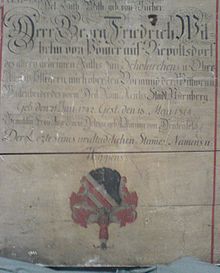Pömer von Diepoltsdorf
The Pömer von Diepoltsdorf were a patrician family of the imperial city of Nuremberg , first mentioned in a document in Nuremberg around 1286. The Pömer were, with short interruptions, represented in the “inner council” from 1395 until the end of the imperial city time in 1806 and belonged according to the “ dance statute "To the" new "advisable genders. In 1814 they went out.
history
The ancestry of the Pömer is not clear. According to the Haller book of 1533, they came from Pomerania and are said to have lived in Nuremberg as early as the late 13th century. In 1286 a "Pomero" was first mentioned in Nuremberg; 1289 an Ortlieb, son-in-law of Pomero (possibly a member of the Ortlieb patrician family ); In 1302 and 1311 the daughter of a Pomero. It is unclear whether these people belong to the later Pömer patrician family.
The Pömer carried out long-distance trade and were married to members of important patrician families such as the Behaim , Haller , Kreß , Pfinzing and Tucher .
In 1395, Georg Pömer was the first member of the family to be represented on the Inner Council and thus became a member of the Nuremberg patriciate . Hector Pömer, the most important representative of the family, was provost of St. Lorenz . In 1522 he appointed Andreas Osiander to be a preacher and thus significantly influenced the Reformation in Nuremberg. Today a street in the Großgründlach district of Nuremberg commemorates him.
In 1689 Georg Christoph Pömer acquired the eponymous manor house of Diepoltsdorf through his marriage to Maria Magdalena Stockammer (Stockamer) and the Pömer have called themselves " Pömer von Diepoltsdorf " since then . In 1697 the addition to the name was recognized as a title of nobility. Georg Wilhelm Pömer had to sell the manor again in 1760 due to economic difficulties. With Georg Friedrich Wilhelm von Pömer von Diepoltsdorf, the Pömer died out in the male line in 1814.
Former possessions (extract)

- ???? - 1425 the village of Röckenhof
- 1370–1514 the Röckenhof manor
- ???? - ???? Property in Kleingeschaidt
- 1568–1579 the Baderschloss in Mögeldorf
- 1611–1632 the Steinach manor house
- ???? - ???? Manorial estate in Menschhof near Kirchensittenbach
- 1689–1760 the mansion "New Housing" in Diepoltsdorf
- 1695–1700 the Vogelsgarten mansion in Tullnau
- 1716–1763 the “Kressenhof” in Erlenstegen
- 1748–1780 the "Pömerschen Sitz" in Erlenstegen (burned down in 1944)
Weiherschloss Röckenhof (around 1680)
"Kressenhof", Erlenstegen
Foundations (extract)
- The Pömerepitaph in the Nuremberg Sebalduskirche from the 18th century records the life data of several generations of the family. (badly damaged in World War II)
family members
- Hector Pömer (1495–1541), provost of St. Lorenz
- Wolf Albrecht Pömer (? -?), Custodian of the Lichtenau Fortress around 1633
- Georg Friedrich Wilhelm Pömer von Diepoltsdorf (1742–1814), the last male representative of the sex
Wolff Pömer (1536–1601), judge and slogan (by Virgil Solis )
Regina Maria Pömer b. Behaim (1646–1669), wife of Gabriel Pömer
coat of arms
Divided diagonally right, beveled four times at the top by red and silver, black at the bottom.
Stone with various alliance coats of arms of the Pömer on the Sebalduskirche
Schembart runner with Pömer coat of arms (16th century)
Epitaph for Johann Friedrich Pömer (1674–1745), Hersbruck City Church
Individual evidence
literature
- Christoph von Imhoff (Hrsg.): Famous Nuremberg from nine centuries . Nuremberg: Hofmann, 1984, 425 pages, ISBN 3-87191-088-0 ; 2., erg. U. exp. Edition, 1989, 459 p .; New edition: Edelmann GmbH Buchhandlung, October 2000
- Michael Diefenbacher : Pömer von Diepoltsdorf, patrician family . In: Michael Diefenbacher, Rudolf Endres (Hrsg.): Stadtlexikon Nürnberg . 2nd, improved edition. W. Tümmels Verlag, Nuremberg 2000, ISBN 3-921590-69-8 ( online ).
- Gerhard Friedrich Albrecht : Genealogical state calendar on the year MDCCLXXVI . Frankfurt / M. 1776, pp. 287-292 ( full text ).
See also
- List of German noble families N – Z
- Patriciate (Nuremberg)
- History of the city of Nuremberg
- Castles, palaces and mansions in the city of Nuremberg

























